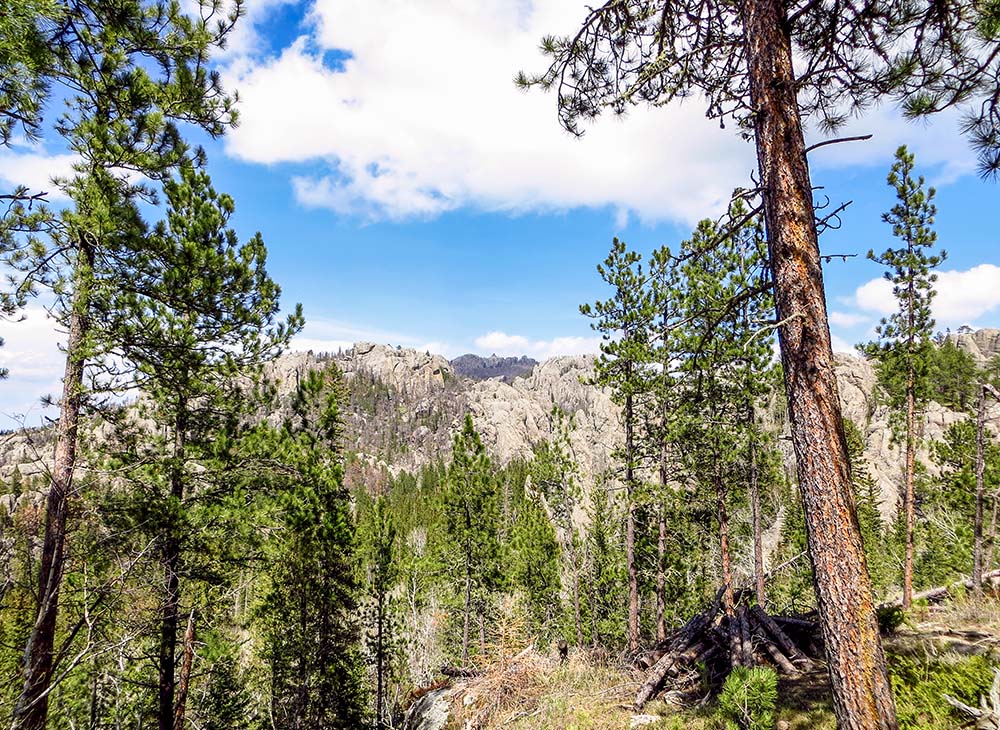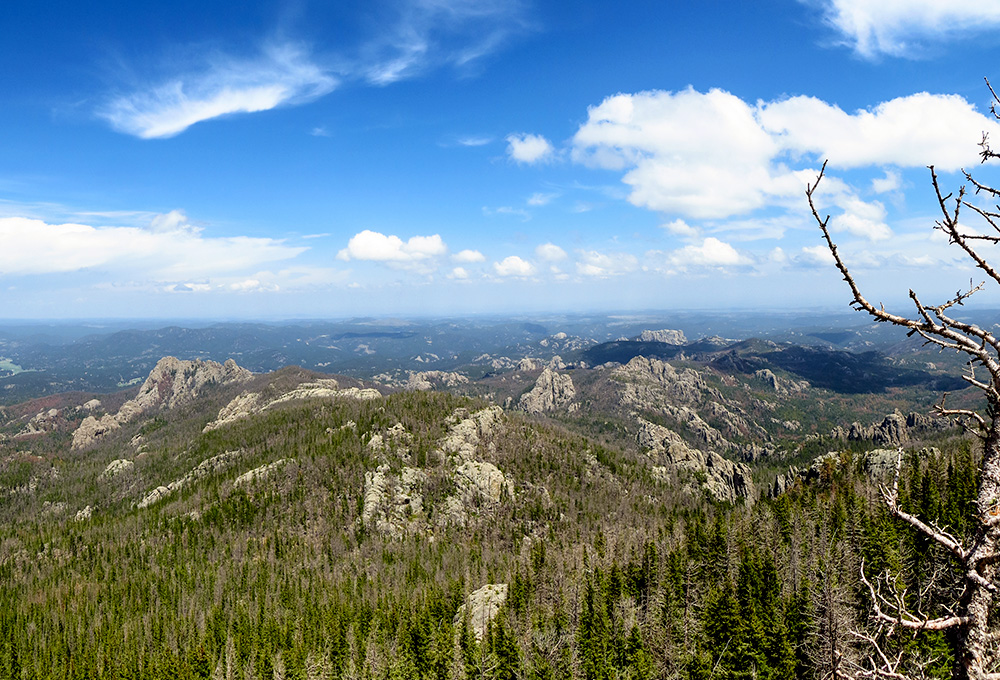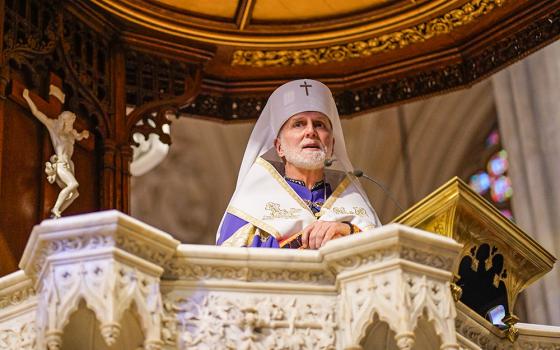
Black Elk Peak in South Dakota is seen in the distance between trees. (Wikimedia Commons/Sam DeLong)
Servant of God Nicholas Black Elk (ca. 1867-1950) spent his life praying with creation. When he died August 17, 1950, 74 years ago, all of creation prayed for him.
To say that Black Elk prayed not only for, but with, all creation is not an exaggeration. Black Elk grew up in traditional Lakota ways and served as a traditional healer. The center of Lakota spirituality is the sacred pipe, which is used in all Lakota ceremonies. Through it, the people connect to the Creator and all of creation.
Black Elk explains in The Sacred Pipe, "All these peoples, and all things of the universe, are joined to you who smoke the pipe — all send their voices to Wakan-Tanka, the Great Spirit. When you pray with this pipe, you pray for and with everything."
When Black Elk accepted baptism in 1904, he continued to pray for and with everything in a new ceremony: the Catholic Mass. Pope Benedict XVI emphasizes in his book The Spirit of the Liturgy that to participate in the Catholic liturgy is "to pray with all of creation." Benedict wrote, "Creation, history, and worship are in a relationship of reciprocity," and that worship "not only saves mankind but is also meant to draw the whole of reality into communion with God."
All of humanity and creation is called to a journey of "divinization," the culmination of which is "God all in all" (1 Corinthians 15:28).
Black Elk's life praying with creation led to deep connection and miraculous events. The most well-known story ends poet John Neihardt's famous book Black Elk Speaks, which details Black Elk's life up until the Massacre of Wounded Knee in 1890.
Advertisement
It was a hot, cloudless Great Plains afternoon in the summer of 1931, the height of the dry season during the dustbowl of the Great Depression, "one of the worst in the memory of the old men," writes Neihardt.
Black Elk had just spent three weeks telling the story of his early life, including his visions, to Neihardt. He wanted to return to the highest mountain in the Black Hills, what today is named Black Elk Peak. He had been taken there in the spirit during his Great Vision at the age of 9. Black Elk had never been back, and he wanted to return to offer a special prayer.
If I still have any power, he told his son, Ben, on the climb up, then there will be a little rain.
On the peak, Black Elk raised his pipe and prayed with all creation: "The four-leggeds and the wings of the air, through them, relative-like we should be, and through them we should send up our voice to you, O Great Spirit!"
Crying, Black Elk recounted the gifts and calling of his Great Vision and finished, "With tears I am sending a voice. May you behold me and hear me that my people may live again!"
As he spoke, a small cloud formed overhead. Low thunder echoed and a light drizzle fell. "For some minutes the old man stood silent, with face uplifted," Neihardt writes, "weeping in the drizzling rain. In a little while the sky was clear again."
Neihardt, who called Black Elk a "saint" in the deepest meaning of the word, was, according to Black Elk biographer Joe Jackson, "astounded."

A view from the top of Black Elk Peak in South Dakota (Wikimedia Commons/Sam DeLong)
Neihardt was also confused. Like many of us today, he understood tears to be negative, reflecting tragedy, failure, unwanted suffering and defeat. That's what Neihardt saw, leading him to cast Black Elk as "a pitiful old man who has done nothing."
But among the Lakota, tears are the deepest form of prayer. The word in Lakota for "to pray," wacekiya, comes from ceya, "to cry." Ritual crying is an important part of ceremony, such as during what is often called the "vision quest" in English, but in Lakota is hanblecheyapi, "crying for a vision" or "lamenting." That's when the spirits and Creator hear you and have mercy. Rather than expressing defeat, tears enact connection and power.
That Black Elk's tears were met with rain on what was a cloudless summer day takes on greater meaning in the ecological context. In a land of sparse precipitation, rain is an embodied blessing that grows the grass and feeds the buffalo and horses. Rain quite literally makes the people live, particularly during drought.
This convergence, of the sky crying with Black Elk, of his prayer met with the prayer of creation, became the lasting image of Black Elk in the public eye and in many ways the high point of his life on Earth. Neihardt made this the dramatic ending to Black Elk Speaks, an Indigenous holy man so intimately connected to the Earth that they act in unison.
Yet Black Elk's greatest connection to the Earth occurred at his funeral. Before his death, he had talked about the possibility of something happening. "Maybe God will show something. He will be merciful to me and have something which will tell of his mercy," his daughter, Lucy Looks Twice, remembered Black Elk saying.

Nicholas Black Elk with his daughter, Lucy Looks Twice, and his wife, Anna Brings White (Denver Public Library Special Collections)
The night of Black Elk's wake there was a massive display of the Northern Lights. Lakota and Jesuit alike took it as the promised sign. John Lone Goose, a fellow catechist, believed that "God sent those beautiful objects to shine on that old missionary."
The day of the funeral brought an even greater wonder. It only came to public attention through Black Elk's cause for canonization. Arthur Amiotte, a prominent Lakota artist, remembered the funeral. He was 8 years old and served as an altar boy at the funeral Mass.
After the Mass, they processed across a road and up a hill to the cemetery. It was difficult getting the wagon with Black Elk up the hill through the mud. They gathered around the grave for the Rite of Committal.
"Just as the ritual began," Amiotte remembered in the documentary "Walking the Good Red Road: Nicholas Black Elk's Journey to Sainthood," "the sky opened and the sun came out. And it seemed only to be happening in that place where we were at the cemetery. And I was astonished."
Then the clouds closed up, the rain continued and the funeral ended. Later, Amiotte's family discussed the event, his grandmother explaining that when such events happen, "we know that they've gone home." Almost 70 years later, the power was still fresh for Amiotte, wonder shining as he spoke: "I thought it was a miracle."
Not only a kind of miracle in and of itself, but the same call and response of sun and rain as Black Elk's 1931 prayer on Black Elk Peak, only in reverse. Instead of some drizzle from a cloudless sky, a flash of sun in the midst of a downpour.
Perhaps the rain was creation praying for Black Elk on his journey. But if Amiotte's grandmother is correct — that the sun showed that Black Elk had already arrived home — then creation's tears were for something else. I'd like to think that it was creation praying with Black Elk and his 1931 prayer for all of us still here on Earth, especially the Lakota and the Indigenous peoples of Turtle Island, that we may live again.







